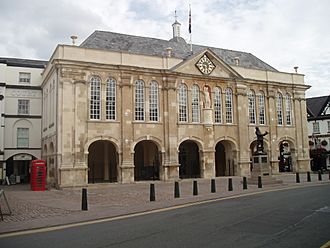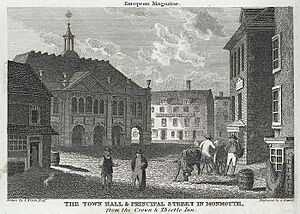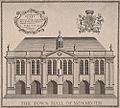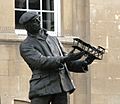Shire Hall, Monmouth facts for kids
Quick facts for kids Shire Hall |
|
|---|---|

Shire Hall, Monmouth
|
|
| General information | |
| Architectural style | Baroque |
| Location | Agincourt Square |
| Town or city | Monmouth |
| Country | Wales |
| Coordinates | 51°48′43″N 2°42′55″W / 51.811973°N 2.715404°W |
| Completed | 1724 |
| Cost | £1,700 |
| Design and construction | |
| Architect | Philip Fisher, Bristol |
The Shire Hall in Agincourt Square, Monmouth, Wales, is a very important historic building. It was built in 1724 and used to be the main court building for Monmouthshire. In 1839 and 1840, a famous trial took place here. It was the trial of John Frost and other Chartist leaders. They were tried for serious crimes related to their fight for people's rights.
The building was also a busy market place. Today, Monmouthshire County Council owns the Shire Hall. Visitors can use audio guides to explore Courtroom 1. It now serves as a Tourist Information Centre and offices for Monmouth Town Council. Parts of the building are open for everyone to visit.
Contents
Exploring Shire Hall's Past
The Shire Hall you see today was built in 1724. It is actually the fourth building to stand on this spot! Before it, there was an Elizabethan court from 1536. That was replaced in 1571 by a building made of wood. The wood from the older building was even used to help build the current Shire Hall.
The new building had an open area on the ground floor for trading. The courtrooms were on the floors above. The Shire Hall is made of Bath stone and cost about £1,700 to build. A less known architect named Philip Fisher from Bristol designed it. The main courts moved into the building in 1725. The clock on the front was made by Richard Watkins in 1765.
Changes and Updates Over Time
In 1828, the inside of the building was updated. A new outdoor staircase was added, which had a glass roof called a lantern. This made the entrance grander. Architects Thomas Hopper and Edward Haycock Sr. helped with these improvements. They made the building bigger along Agincourt Street. This created space for the new staircase and larger courtrooms.
The Statue of King Henry V
Above the main entrance, below the clock, there is a statue of King Henry V. Many people think this statue is not very good quality. It was added in 1792 by Charles Peart, a sculptor from nearby English Newton. The inscription says: "HENRY V, BORN AT MONMOUTH, AUG 9TH 1387." However, experts now believe the birth date carved on the statue is wrong.
The Chartist Trials at Shire Hall
The Shire Hall was the site of a very important trial in British history. This was the trial of the Chartist leaders. The Chartists were a group of people who wanted all men to have the right to vote in elections.
The Chartist Movement and Its Leaders
One Chartist leader, Henry Vincent, was held in the Monmouth County Gaol nearby. He was later tried at the Shire Hall. Vincent was found guilty, which made many people unhappy. This led to protests, and sadly, some miners were killed in a clash with soldiers in Newport on November 4, 1839.
Soon after, John Frost and other Chartist leaders were arrested. A special court session began at Shire Hall on December 10, 1839. A group of important people, including members of Parliament, decided what charges to bring against them.
The Historic Trial of John Frost
Frost, William Jones, Zephaniah Williams, and five others were charged with a very serious crime against the government. Their trial started on December 31. It is known as one of the most important trials in British law.
The judges included the top judge, Sir Nicholas Tindal. The lawyers for the government included the Attorney General, Sir John Campbell. Sir Frederick Pollock was Frost's lawyer.
During the trial, soldiers were brought to Monmouth to keep the peace. They stayed at the White Swan and guarded the Monnow Bridge. All eight men were found guilty. However, the jury asked for mercy for them.
Sentencing and Royal Mercy
On January 16, 1840, the judge sentenced Frost, Jones, and Williams to a very harsh punishment. They were the last people in Britain to receive such a sentence. The other five men were sentenced to be sent away to a faraway land.
Just before their sentences were to be carried out, the government asked Queen Victoria to change the punishments. The Queen agreed, and all the sentences were changed to being sent away. On February 2, 1840, the prisoners were taken to Portsmouth. From there, they sailed to Van Diemen's Land (now Tasmania, Australia).
Shire Hall Today
When Monmouthshire County Council was formed in 1889, most of its work moved to Newport. This was because Newport had become the main town in the county.
Renovation and Modern Use
The local courts at Shire Hall in Monmouth closed in 1997 and 2002. Then, Monmouthshire County Council received a large grant of £3.2 million to fix up the building. The council also added over £1 million.
The renovation started in late 2008. The newly restored building opened in September 2010. Visitors can now see the courtroom where the famous Chartist trial took place. A new lift was installed, making the whole building easy for everyone to access.
Today, Shire Hall has a Tourist Information Centre and offices. It is open to the public most days of the week.
Shire Hall's Surroundings
The Shire Hall and the area around it have been used in TV shows, like a Doctor Who Christmas special in 2008.
Agincourt Square Landmarks
Right in front of Shire Hall in Agincourt Square, there is a statue of Charles Rolls. He was born in Monmouth and was a pioneer in cars and aviation. The statue was put up in 1911 to remember his achievements.
Across the square is the Kings Head Hotel. This old hotel dates back to the mid-1600s. It is said that Charles I of England visited it in 1645. Other important buildings in the square include the Beaufort Arms, which was once a coaching inn, and Agincourt House, a beautiful old wooden building from the 1600s.
Images for kids
-
Geoffrey of Monmouth display in court room two
See also
 In Spanish: Shire Hall para niños
In Spanish: Shire Hall para niños

























